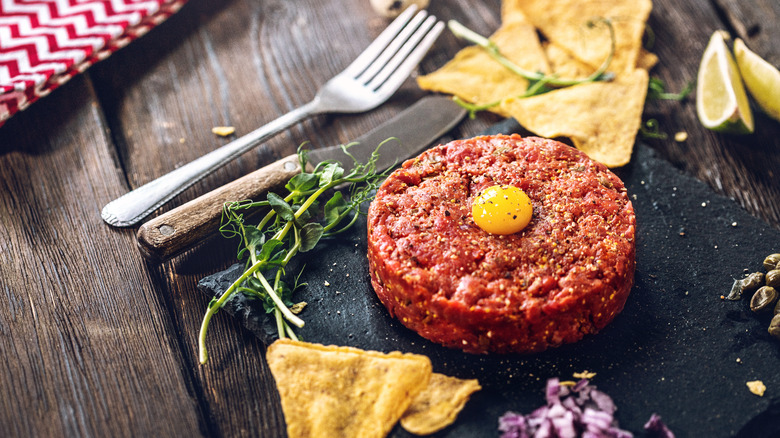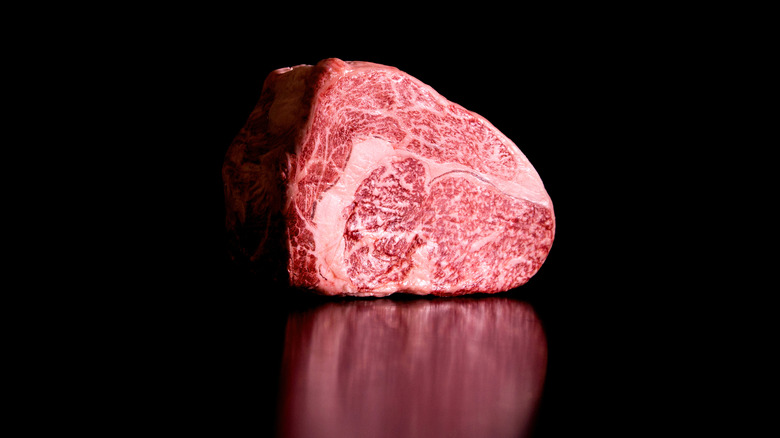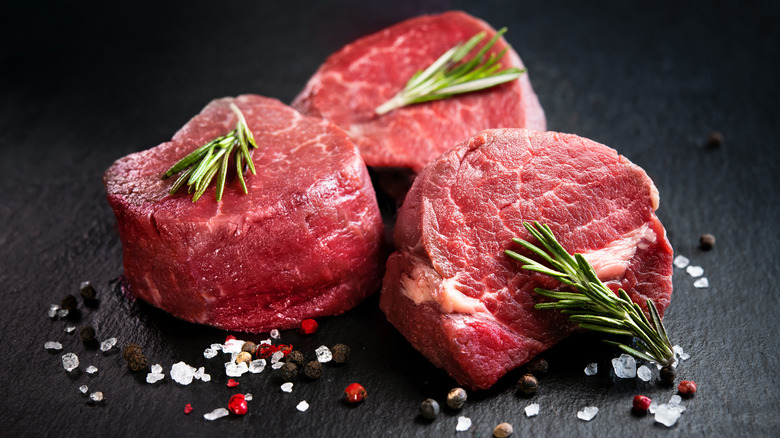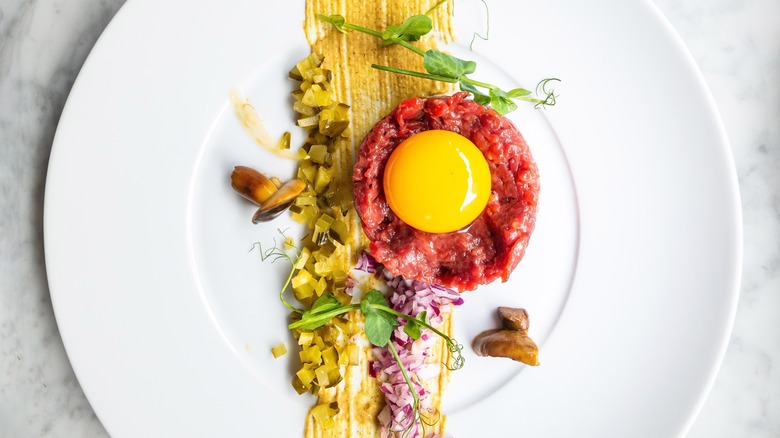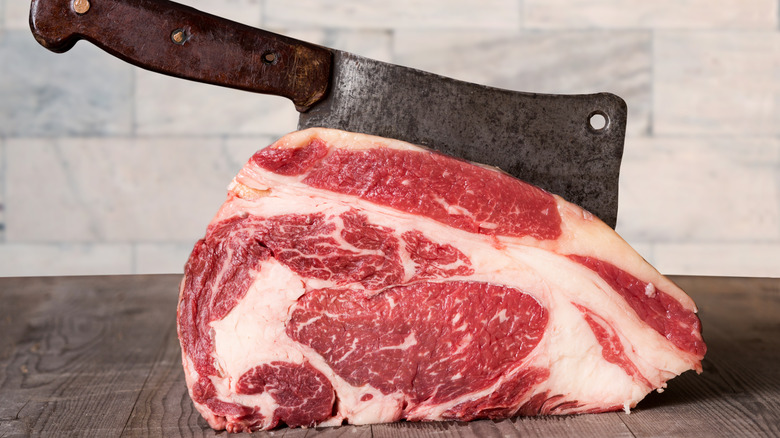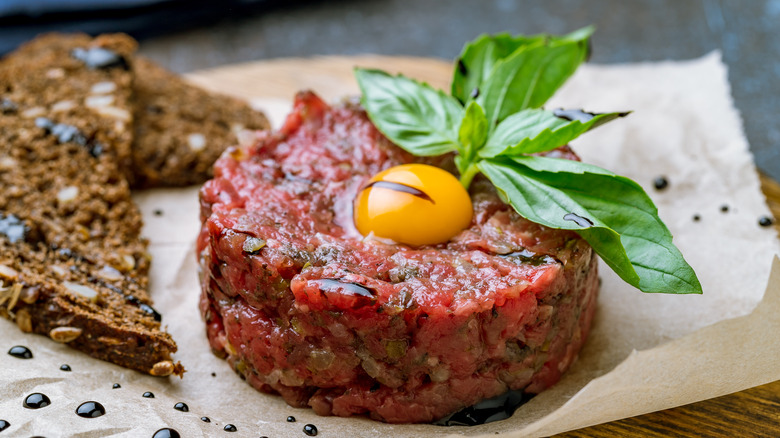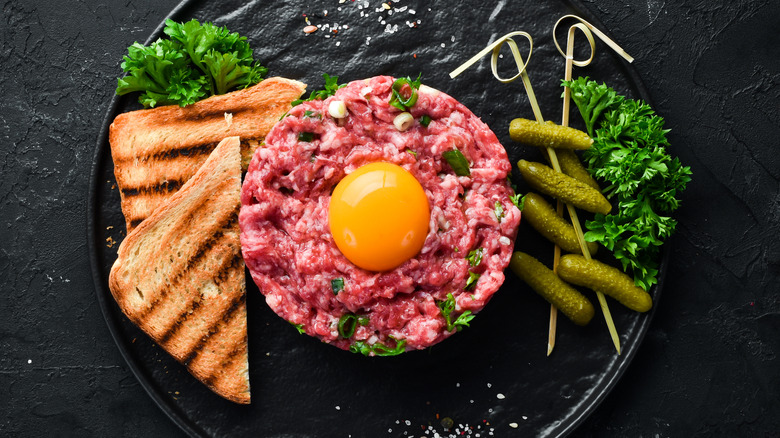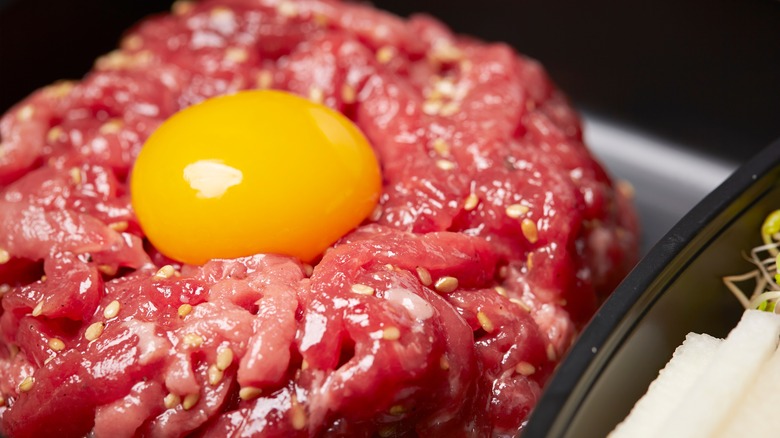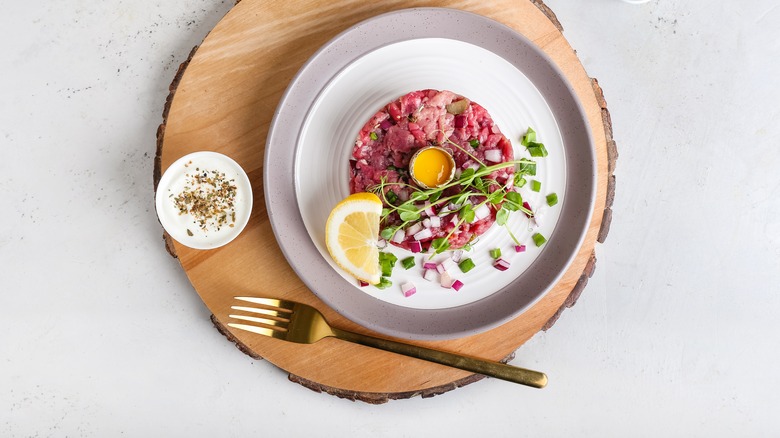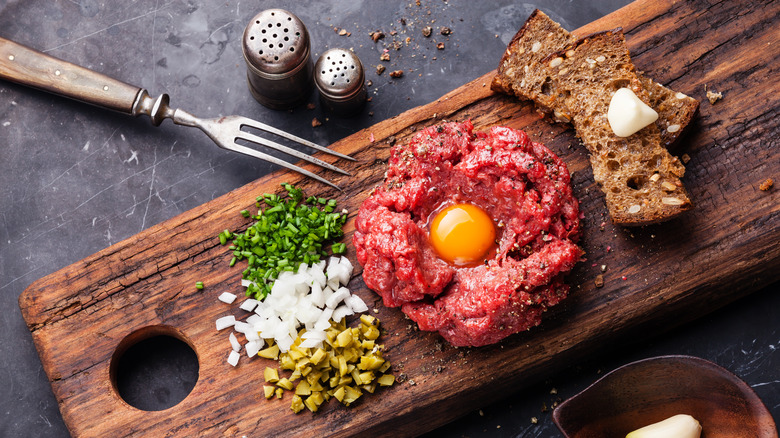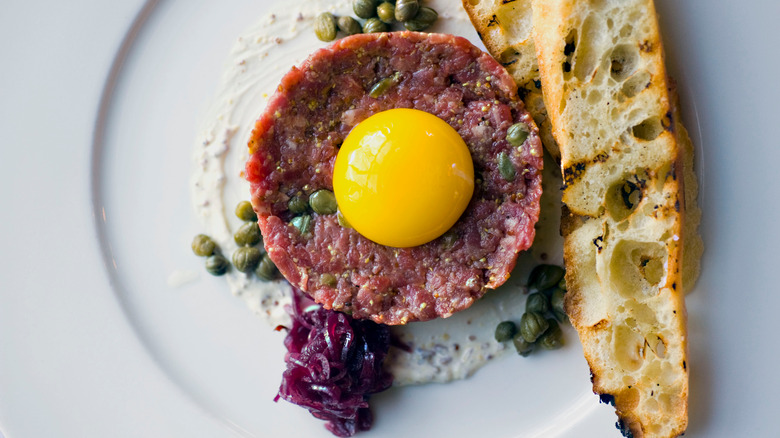10 Tips For Making Delicious Steak Tartare At Home
Steak tartare is not a dish for the faint of heart. After all, its main ingredients are some of the most controversial culinary items available in today's food safety-savvy society. Only those comfortable with the idea of consuming raw beef, raw egg yolk, gherkins, mustard, capers, and raw onions will even consider giving steak tartare a try, and, of those willing to try it, even fewer may actually enjoy the taste, texture, and concept of the unusual combination.
But for the bold and the brave rare beef lovers of the world, steak tartare is more than just a delicious delicacy — it's a testament to one's culinary prowess, their ability to source quality ingredients, prepare them just so to bring out their best qualities (without the crutch of cooking them), and to nail that perfect balance of a flavor and hit the bullseye between bright, rich, salty, sweet, savory, acidic, and every other flavor that combines and coalesces to become harmony on the plate and palate.
Considering the precision, skill, and confidence it takes to pull off a great steak tartare outside of a professional kitchen, it's easy to see why few home cooks ever risk making this daunting dish. But by learning just a few tips for making delicious steak tartare at home, you can remove the mystery behind turning a pile of raw meat into a downright treat. And after you know the tartare rules, you can break them for some wildly inspired tartare.
1. Invest in quality beef
When you're planning to tackle a big project, making sure you start the process well-equipped with all the right tools for the job is usually the absolute best place to begin. This rule extends to work, family, life, and — as you may have guessed — the kitchen as well. In the context of restaurant-quality homemade steak tartare, the "start smart" rule applies particularly well.
In that same line of thought, the first and most important part of the whole tartare-making process that must be squared away before starting is (of course) getting your hands on some incredibly high-quality beef. In much the same way that chefs and home cooks alike share a discerning eye for what kind of fish they'll use for making uncooked dishes such as sushi, poke, or ceviche, the same attention to detail must be paid to other raw meats as well. And, of all the beef you can buy at the local supermarket, some is suitable for eating raw but most simply isn't.
In order to avoid the amateur mistake of eating low-quality raw beef, make sure to shop at a trustworthy market and check with your local butcher before buying anything. Don't feel bad about asking either since butchers are the literal experts when it comes to raw meats and grades of beef. So, start the steak tartare process with a piece of beef you'll want to eat uncooked — after all, you're eating it raw ... it had better be good!
2. Get the right cut of beef
Once you decide to set out and find the perfect high-grade beef for your at-home steak tartare recipe, the next logical question on your mind is probably going to be, "Wait — what cut is best for tartare?" And the answer is simple if repetitive: just ask your butcher. Not only will your butcher be able to run you through the individual qualities of each kind of cut of beef, but they will also know exactly what they have in stock, how long it's been there, where it came from, how it's been treated, and anything else that may be important to know before deciding to eat meat without cooking it.
If you happen to know that all of the beef options available to buy are completely safe and approved for raw consumption and want a little more agency when it comes to selecting the best cut, then a few extra tips may come in handy. First and foremost, be sure to choose the best cut of beef in accordance with your personal preference rather than its mass appeal. The benefit of making a dish like tartare at home is that it can be made exactly to taste — just aim for a cut of beef that is tender. This means no tough cuts, no beef high in chewy cartilage and connective tissues, and certainly nothing bland or boring. The most popular cuts of beef for homemade steak tartare are sirloin, tenderloin, and filet.
3. Farm fresh eggs for flavor
Farm fresh is always best, especially when it comes to finding that perfectly rich, vibrant egg yolk, with a color so deeply gold that it looks almost orange. A top-tier egg yolk like that not only brightens up the visual appeal of a dish, but also adds an inexplicably indulgent layer of rich flavor and texture that's impossible to replicate with any sort of substitute.
Raw egg yolks are a common enough ingredient in and of themselves and can be found across culinary creations and condiments such as mayonnaise and Caesar salad dressing. But in the case of steak tartare, the egg yolk is not hidden away amidst a million other strong flavors, emulsified and blended out of sight as more of a base for a sauce rather than a star. No, steak tartare celebrates those canary-yellow yolks and wears them like a jaunty golden crown.
Buying farm-fresh eggs for your homemade steak tartare recipe isn't just ideal — it's also accessible, easy, and affordable. And since the true effect of the steak tartare experience is completely and utterly lost unless it comes with the quintessential yolk pop moment when you break that perfectly round, self-bound orb and let its content run down and coat the beef below. Without an egg on top, the tartare loses its magic and nothing remains to bind the individual ingredients' unique and powerful flavors together to make them sing in harmony.
4. Its all in the knife
How would you feel if you got all dressed up for dinner, drove down to that fancy new restaurant you've been dying to try, and ordered the sublime-sounding steak tartare appetizer, only for all that effort to be met with a pile of ground beef dressed up like tartare? You'd probably be a bit disappointed, and most everyone would at least consider (if not follow through on) sending the plate back to the kitchen pronto. Why then, would anyone consider skipping the essential skill required for real steak tartare? Without proper knife skills, steak tartare is really more of a steak tartaren't.
To master the knife skills essential for top-notch steak tartare, you must master various techniques and consistency with cuts, and then practice until each movements are down to muscle memory. The onion and/or shallot used in the actual body of the dish must be finely chopped and the same size across the board. The beef itself must be sliced into small sections that are close to lines of ground beef in size, but still manage to retain the texture and body of an unground bite of beef.
To achieve this level of blade work, you must also (alongside developing your personal skillset) tend to the practical matter of knife maintenance. So, before you start slicing away, make sure your knife is as sharp as possible to ensure those clean, effortless cuts you want.
5. Study up on steak tartare
The simplicity of steak tartare is both a problem and its point of strength when it comes to culinary clout. In this dish, there is no room to hide a mistake, an imbalance, or a missing ingredient. Tartare is so simple that it actually manages to loop all the way back around to being a difficult dish again. That's why, with a dish this minimalistic, it's more important than usual to have each ingredient, hit every step of the process, and to trust the recipe as well as its source. And if deciding which steak tartare recipe is best proves difficult, you can also choose to rely on the advice of a trusted cook, like that of renowned culinary figurehead and celebrity chef, Wolfgang Puck, whose social media stance on steak tartare caused quite the commotion recently.
By the time you get around to making tartare, you need to know the recipe backward and forward — and while you're at it, you could also write down the recipe with precise measurements and save it for after the dining process so that you can make notes for the next time you want to make steak tartare. With every iteration of the recipe, the quality will improve and the results (though not immediate) will ensure you eventually have a homemade steak tartare recipe so good that just a taste would intimidate a Michelin Star chef.
6. Get that flavor balance just right
Steak tartare is a very rich dish, full of hearty meat and creamy yolk. This base richness of these ingredients naturally means that whoever's cooking the tartare must be sure to utilize acidic ingredients (such as pickles or capers) in order to bring lightness to an otherwise heavy flavor profile. The chefs cooking in restaurants have mastered this balancing act and know exactly how to best use that juxtaposition between light and dark, hard and soft, bitter and sweet ... they're all essential in adding contrast to just about every cuisine. Flavors blend, meld, support, enforce, and, above all, complement each other to the best of their inherent ability.
By choosing to prioritize making the marriage of ingredients harmonious, your homemade steak tartare will be infinitely closer to tasting as good as anything you can get at a restaurant (and for significantly less money spent, too). And remember — it's a whole lot easier to salvage a sauce than it is to retroactively re-season an already seasoned dish. So, make sure to have the entire steak tartare seasoning already balanced and set aside before adding any beef.
7. Don't take any shortcuts
The last thing you want to do with this dish, and the hands-down worst steak tartare you can make, is to cut corners, take shortcuts, or otherwise get lazy about an already easy (in theory) recipe. This tartare tip is so important, it's worth saying again: when so few ingredients are presented so simply, each and every step must be performed to perfection and there can be no ifs, ands, or buts about it. And if you ever find yourself wondering idly if you really have to go that extra mile to the better butcher in town or pay that extra dollar for farm fresh eggs, remember that ground beef and grocery store eggs make a perfectly delicious loco moco, meatloaf, and many more less raw and finicky recipes that can satisfy that beef and eggs craving without calling for any culinary mastery.
At the very least, make steak tartare down to the letter of whichever recipe you desire, and only trim down excess steps if and when you've had a chance to taste the full effort of your labors. And if making steak tartare the way steak tartare deserves to be made is just too much effort, consider saving the recipe for another day. Just remember, with a dish that requires no cooking, there's no excuse to be anything less than entirely committed to achieving close to perfection with each and every step!
8. Get creative with garnishes
Steak tartare is one of those famously fun and fancy foods, often served in such an aesthetically pleasing pile of pieces of meat, topped with an egg, and garnished to perfection with any number of dazzling additions. This dish is a blank canvas, one which asks its creator to delve into that well of inspiration and decorate it with festive ingredients. Common toppings for steak tartare are quail eggs (like chicken eggs, but smaller, richer, and cuter), micro greens, sesame seeds, shallots, onion or garlic greens, lemon, special seasonings, and more. The only limit a home cook has when it comes to decking out their tartare dish is imagination and access to eccentric ingredients.
A great way to get the creative juices flowing and start brainstorming ways to augment a steak tartare is to look at whatever ingredients are local, in season, and grown fresh. By containing your garnishes to those local, seasonal parameters, you ensure two things: the guaranteed flavor boost that comes from perfectly ripe ingredients, as well as a cohesive seasonal twist to your steak tartare. Restaurants, especially the fancy ones, often utilize this cooking trick. In fact, you can easily watch menu items come and go with the weather. Morels in spring, cucumber in the summer, pumpkin-spice everything for autumn, and cranberries around Christmas ... it's all part of a predictable and delectable calendar of cuisine.
9. Serve immediately
One thing about steak tartare is that it isn't the kind of dish that you should let sit for any substantial amount of time before serving it up. Ideally, the entire process should be as fresh as chopping, mixing, plating, and eating with no glaring time gaps between. And, like a surprisingly high number of dishes, steak tartare tastes best when everything, beef and eggs included, are at a food-safe room temperature. For those who don't know, foods (especially raw meats) can only be eaten if they stay below a certain temperature, which explains preservative methods such as curing, pickling, and freezing.
Raw and rare steak is usually safe to eat if the quality is high and the temperature is kept low (or alternatively the meat is cooked to a high enough temperature to render it food safe), but that doesn't mean that a steak tartare should be allowed to sit out on the counter just so it can be exposed to heat, bacteria, and whatever else may be floating by at the time. So, get your mise en place and your diners are hungry for some rare steak apps when you make the call to put it all together and make some tartare magic happen. Much like revenge, steak tartare is a dish best served ... at least relatively cool, and preferably without food poisoning.
But with a little attention to temperature and timing, it's easy to keep your homemade steak tartare fresh and safe to enjoy.
10. Can't forget the crostini
Like many of the world's best culinary creations (including sandwiches, pizza, tacos, and gyros), steak tartare is nothing without a carby vessel to eat it on. Something about a crostini, with its slightly charred, crisp exterior and that chewy bready center ... well, it is the backbone that holds the entire tartare together, bringing that last bit of balance to an otherwise overwhelming assortment of powerful flavors. By letting the crostini carry some of the tartare's inherent boldness and make it just a little more mellow, this meal goes from questionable to downright delectable.
To make a great crostini at home is easy: simply buy some nice bread, cut off some slices, season them with olive oil (and possibly herbs or vinegar), and grill until toasty and charred, preferably with those classic parallel lines that mark a perfect char. But don't confine yourself to only cooking crostinis as an accompaniment to your steak tartare. There are a ton of titillating variations to try, many of which add an entirely unique twist to the classic tartare experience. Homemade potato chips, for instance, make a fantastically fun and crispy addition to any steak tartare. In the same vein, tortilla chips and pita chips are excellent crostini substitutes.
The only unacceptable substitute for a crostini when it comes to steak tartare is none at all, so don't be afraid to experiment and figure out what fun ways you can find to serve your homemade steak tartare.
